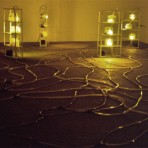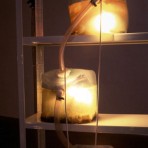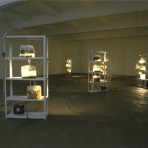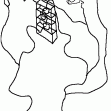Hertford Union punctured the membrane that divided a controlled art space from the complicated, awkward world outside spaces. Dirty water from the canal was pumped into the gallery via a hole drilled in the wall. From this opening emerged an intricate system of see-through plastic tubing, a network of arteries and capillaries that conveyed the water around the space. Before being returned, the water then flowed through a series of homespun filtration units.
- Chisenhale
- Filtration Units
- Chisenhale2
- Two holes drilled in back wall
The only light in the space emanated from the filtration units themselves. Each container was lit from within by an underwater light, powered by car batteries that slowly died in a daily cycle. In a process reminiscent of dialysis, Hertford Union was a futile attempt at cleaning the vast inter-connected bodies of impure water that lie outside the gallery.




